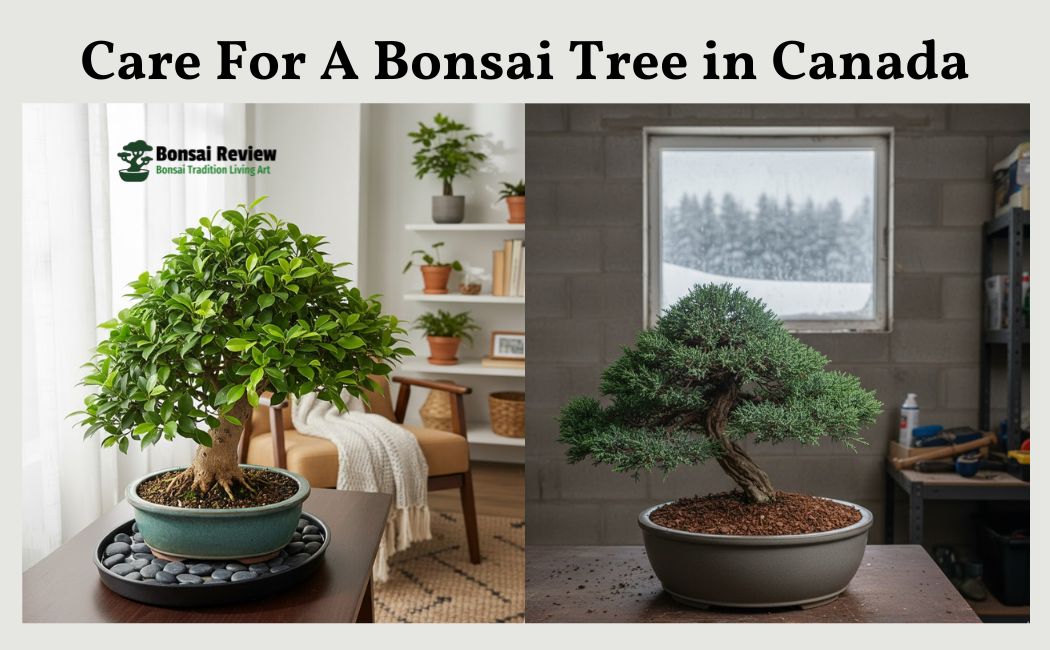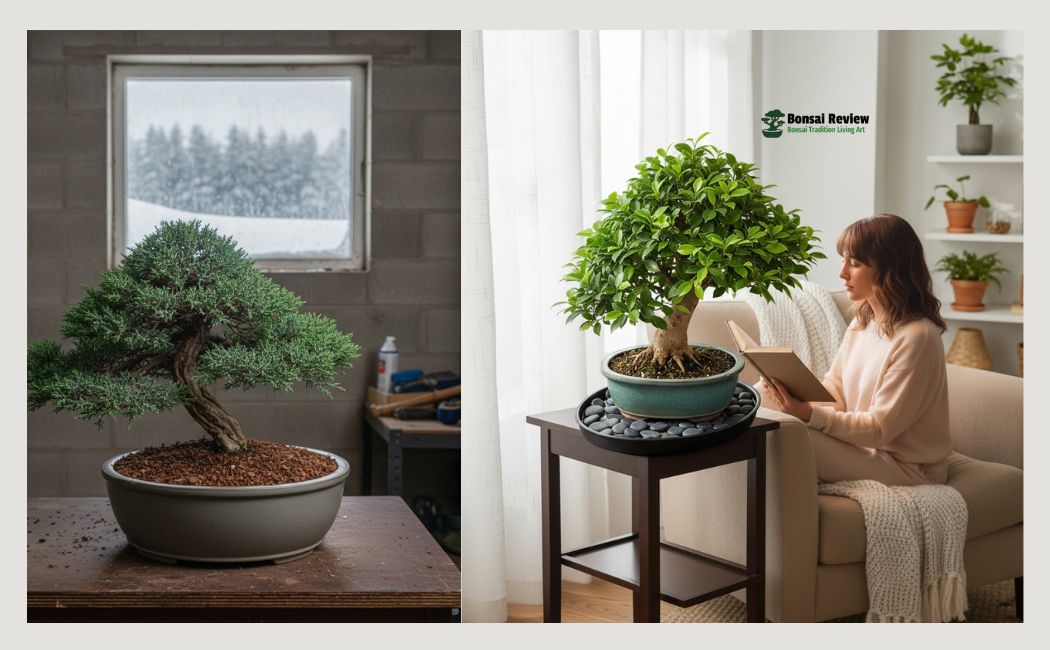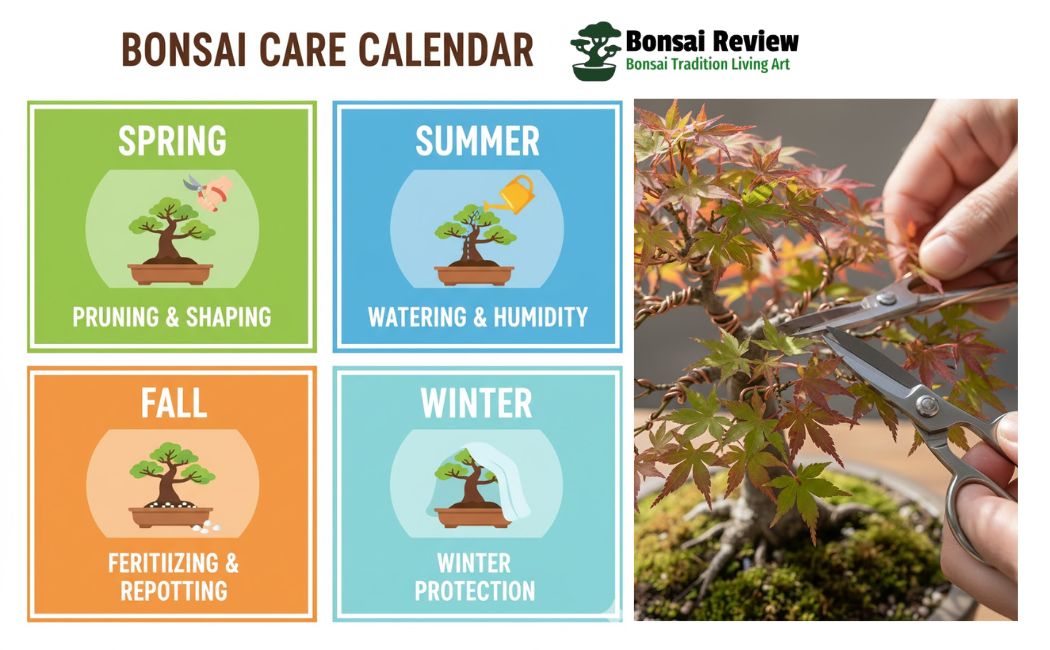Care for a bonsai tree in Canada can feel tricky when the cold winters, dry indoor air, and short daylight hours test your tiny tree’s strength. For beginner dwarf plant lovers, it’s care for a bonsai tree in Canada means practicing how to balance warmth, light, and water through long winters.
If you grow an indoor bonsai like a Ficus microcarpa or Jade plant, place it near a south-facing window where it can soak in bright light or under grow lights during darker months.
You might notice yellow leaves, slow growth, or dry soil even when you water; that’s because most bonsai care guides forget Canada’s mixed climate. But don’t worry; you can keep your indoor bonsai or outdoor bonsai healthy with just a few small changes.
Start by matching your tree to your home’s USDA Plant Hardiness Zone. Hardy types like Juniper, Norway Spruce, or Japanese Maple can live outside with winter protection, while Ficus microcarpa, Chinese Elm, or Jade plant love the warmth inside.
Place your indoor tree near a south-facing window or under grow lights for steady light, and add a humidity tray or mist the leaves to fight the dry indoor air.
During colder months, move outdoor trees into an unheated garage, cold frame, or insulated pot to protect their roots from freezing.
With the right watering schedule, a touch of organic fertiliser, and steady maintenance pruning, your bonsai will stay green and strong through every Canadian season.
Understanding Canada’s Bonsai Climate Challenge
If you live in Canada, your bonsai faces a very different world from one grown in tropical or mild areas. The long, freezing winters, sudden temperature drops, and dry indoor air from heaters can all confuse your little tree.
Some species, like Juniper, Norway Spruce, or Japanese Maple, actually need a winter dormancy period to rest, but that same cold can also damage their roots if not protected properly.
Indoor growers have their own fight. When the sun hides early and windows frost over, your Ficus microcarpa or Jade plant may not get enough light or humidity to grow well. Using grow lights, a humidity tray, or gentle misting helps balance that dryness.
In outdoor setups, snow and frost can freeze the shallow container or crack the bonsai pot, so it’s smart to store your tree in a cold frame or unheated garage during deep winter.
The key is knowing your USDA Plant Hardiness Zone and matching your bonsai species to care for a bonsai tree in Canada. Each species type has its own rhythm; some rest in cold, others thrive in warmth. Once you understand how Canada’s seasons affect your tree’s life cycle, caring for it becomes simple, steady, and joyful.

Why You Shouldn’t Ignore Heat Stress Early Signs?
When your bonsai experiences heat stress, small warning signs begin to appear, but most people miss them. Ignoring these early signs is like letting a tiny fire spread until it consumes the entire forest. Here’s what usually happens when you overlook care for a bonsai tree in Canada:
- Leaves start to curl or crisp. It’s not just “summer dryness,” it’s your tree begging for help.
- Growth slows down. You might think your bonsai is resting, but it’s actually struggling to stay alive.
- The soil dries too fast. When heat builds up, water evaporates before the roots can drink it.
- Roots suffocate. Extreme heat can compact the soil and cut off air flow.
When you act early by shading, misting, or moving your tree, you protect both its beauty and its health. The longer you wait, the harder Care For A Bonsai Tree in Canada is for your bonsai to recover from the shock.
Key takeaway: Early action saves your bonsai’s life. Treat heat stress the moment you spot it before it becomes a slow, silent killer.
How to Help a Bonsai Recover from Heat Stress Step-by-Step?
If your bonsai has already suffered from too much heat, don’t panic; you can still help it bounce back. Think of this as a little rescue mission for your tree. Each step matters to restore its strength and stop further damage.
Here’s exactly what to do to care for a bonsai tree in Canada:
- Move it to a shaded spot: Take your bonsai out of direct sunlight. A bright but cool area helps it breathe without more stress.
- Water deeply and slowly: Let the soil soak up water until it’s evenly moist, not soggy. This rehydrates the roots without drowning them.
- Mist the leaves: Use a spray bottle to cool the foliage. Misting also raises humidity, which helps your bonsai recover faster.
- Trim damaged leaves and twigs: Cut off dried or burned parts so the plant can focus on healing and healthy growth.
- Check soil and repot if needed: If the soil feels compacted or crusty, refresh it with a well-draining mix. Heat often breaks down soil texture.
- Keep air flowing: Good airflow prevents fungus and helps your tree regain strength. Avoid keeping it in a closed or stuffy place.
Pro Tip Care For A Bonsai Tree in Canada: Use filtered or rainwater if possible. Tap water often carries minerals that can stress an already weak bonsai.

How to Help a Bonsai Recover from Heat Stress Step-by-Step?
| Step | Action | Purpose / Result |
| 1. Move it to a shaded spot | Shift your bonsai to a bright but cool area away from direct sunlight. | Reduces stress and prevents further leaf burn. |
| 2. Water deeply and slowly | Water the soil until evenly moist, not soggy. | Rehydrates roots without causing rot. |
| 3. Mist the leaves | Spray a fine mist on the leaves once or twice a day. | Cools the foliage and boosts humidity. |
| 4. Trim damaged leaves and twigs | Prune away dried or burned parts. | Helps the tree focus energy on healthy new growth. |
| 5. Check soil and repot if needed | Replace compacted or broken-down soil with a fresh, well-draining mix. | Restores soil structure and oxygen flow. |
| 6. Keep air flowing | Ensure proper ventilation around the bonsai. | Prevents mold, fungus, and further stress. |
| Pro Tip: | Use filtered or rainwater instead of tap water. | Avoids mineral buildup that can harm weak roots. |
Best Preventive Habits to Protect Your Bonsai from Future Heat Stress
Now that your bonsai is on its way to recovery, let’s make sure it never goes through that struggle again. Prevention is the key to keeping your bonsai strong and happy all summer long. When you build good daily habits, your tree adapts better to Canada’s shifting weather and dry air.
Start with consistent watering, not too much, not too little. Check the soil each morning; if the top feels dry, it’s time for a gentle soak. During hot days, water early in the morning or late evening to keep roots cool.
Next, monitor sunlight hours. Bonsai like Ficus or Chinese Elm enjoy filtered light, while pines or junipers can handle more sun. A bit of afternoon shade helps every tree avoid leaf burn during heat waves.
You can also use mulch or moss on the soil surface. It locks in moisture and keeps roots from overheating. A humidity tray placed under the pot also helps balance dry indoor air, especially when the air conditioning runs.
And don’t forget regular pruning and soil care, keep your bonsai’s system healthy. Strong roots and clean airflow make Care For A Bonsai Tree in Canada tougher against sudden temperature changes.

Choosing the Right Bonsai Species for Canadian Climates
Selecting the right bonsai species is one of the most important steps if you want your tree to thrive in Canada. Not every bonsai can survive cold winters or dry indoor air, so knowing which ones match your environment makes care much easier.
For indoor bonsai, species like Ficus microcarpa, Chinese Elm, and Jade plant do well. They enjoy warmth, bright light from a south-facing window, or supplemental grow lights, and can handle dry indoor air if you use a humidity tray or mist the leaves regularly. These species are perfect if you want a bonsai statement plant that stays green year-round.
For outdoor bonsai, hardier species like Juniper, Norway Spruce, Japanese Maple, and Alberta Spruce are ideal. These trees need a winter dormancy period and protection from frost.
Moving them to an unheated garage, cold frame, or an insulated pot during extreme cold keeps the roots safe, while mulch on top of the soil maintains moisture.
By matching your species type to your USDA Plant Hardiness Zone, you give your bonsai the best chance to flourish indoors or outdoors. Choosing the right tree from the start makes every other step, watering, pruning, and fertilizing, much easier.
Watering and Fertilizing Your Bonsai in Canada
Proper watering and fertilizing are the foundation of healthy bonsai growth, but Canadian climates make care for a bonsai Tree in Canada a bit tricky. Whether your tree is an indoor bonsai or an outdoor bonsai, understanding its needs by species type and seasonal changes is key.
For indoor bonsai like Ficus microcarpa or Jade plant, water generously when the soil moisture on top feels slightly dry.
Make sure the entire root mass is saturated, but avoid soggy soil, as drainage is essential to prevent root rot. Using a humidity tray or misting helps counteract dry indoor air from heating systems.
Fertilize every two weeks during the growing season with a gentle liquid or organic fertiliser, and pause feeding during the winter dormancy period.
For outdoor bonsai such as Juniper, Norway Spruce, or Japanese Maple, water less frequently in winter but never let the roots dry out completely.
Use a well-draining bonsai soil mix to maintain proper hydration, and feed monthly during the growing season with a solid, organic fertilizer.
Monitoring your USDA Plant Hardiness Zone helps you adjust watering and feeding to seasonal temperature changes.
Consistent attention to water and nutrient routines ensures your bonsai remains strong, vibrant, and ready to weather Canada’s seasonal swings.
Pruning, Wiring, and Repotting for Healthy Growth
Maintaining the shape and health of your bonsai is just as important as watering and feeding. Pruning, wiring, and repotting help your bonsai develop a strong structure and thrive through Canadian seasons.
Pruning is essential for both indoor bonsai and outdoor bonsai. For maintenance, trim shoots when they reach four or five leaves back to two or three to preserve the shape. Major structural pruning should be done while the tree is dormant to avoid stressing the roots and foliage.
Wiring allows you to train branches into your desired form. Use soft bonsai wire and check it regularly to prevent cutting into the bark as the tree grows. Spring and early summer are ideal times for wiring new growth.
Repotting ensures healthy roots and soil. Most bonsai should be repotted every two to three years using a well-draining bonsai soil mix. Carefully trim old roots and refresh the soil to maintain nutrient flow.
For outdoor bonsai, choose a time that avoids extreme cold, while indoor bonsai can be repotted in early spring when growth resumes.
Regular attention to these techniques keeps your bonsai balanced, healthy, and ready to withstand Canada’s challenging indoor and outdoor climates.

Winter Care: Protecting Your Bonsai During the Cold Months
Winter in Canada can be harsh for bonsai trees, and proper protection is essential to keep them alive. Both indoor bonsai and outdoor bonsai need adjustments to survive the freezing temperatures and dry air.
For tropical indoor bonsai like Ficus microcarpa or Jade plant, make sure they stay in a warm, bright spot near a south-facing window or under grow lights. Avoid placing them near heating vents, which can dry out leaves quickly. Use a humidity tray or mist leaves regularly to maintain adequate moisture.
For hardy outdoor bonsai such as Juniper, Norway Spruce, or Japanese Maple, winter protection is critical. You can move them to an unheated garage, cold frame, or use an insulated pot to shield roots from freezing.
Mulching the soil also helps preserve moisture and temperature. Even dormant trees still need some water, and check the soil regularly and water when temperatures are above freezing, but avoid letting the roots become soaked.
Monitoring temperature, wind, and soil moisture ensures your bonsai survives winter and is ready to resume growth in spring. With careful planning, even Canada’s coldest months won’t harm your miniature masterpiece.
Seasonal Maintenance Calendar for Canadian Bonsai Growers
A bonsai maintenance calendar makes it simple to keep your tree healthy all year, especially with Canada’s shifting seasons. Following a clear schedule ensures your indoor bonsai and outdoor bonsai get the right care at the right time.
Spring: Care For A Bonsai Tree in Canada
- Repot bonsai that need fresh soil using a well-draining bonsai soil mix.
- Perform maintenance, pruning, and wiring to shape new growth.
- Begin regular watering and fertilizing with a gentle organic fertilizer.
Summer: Care For A Bonsai Tree in Canada
- Water more frequently as the soil dries faster in the heat.
- Ensure humidity is adequate for indoor trees and consider afternoon shading for outdoor species.
- Continue light pruning and monitor for pests.
Fall: Care For A Bonsai Tree in Canada
- Gradually reduce fertilization as growth slows.
- Prepare outdoor bonsai for winter by moving them to protected areas or using insulated pots.
- Monitor soil moisture closely as temperatures drop.
Winter: Care For A Bonsai Tree in Canada
- Keep tropical bonsai indoors near a south-facing window or grow lights.
- Protect hardy outdoor bonsai in a cold frame, unheated garage, or with mulch over roots.
- Water carefully, only when the soil is slightly dry, and avoid letting roots freeze or become waterlogged.
Using this seasonal plan helps your bonsai adapt naturally to Canada’s climate while keeping your trees strong, green, and ready to thrive year-round.
Conclusion: Keep Your Bonsai Healthy in Canada: Simple Habits, Big Results!
Care For A Bonsai Tree in Canada may seem challenging at first, but with the right approach, your tree can flourish both indoors and outdoors.
By understanding your USDA Plant Hardiness Zone, choosing the right species type like Ficus microcarpa, Juniper, or Japanese Maple, and following a consistent bonsai maintenance calendar, you give your tree the best chance to thrive.
Pay attention to watering, fertilizing, pruning, and wiring, and protect your bonsai during the harsh winter months with an unheated garage, cold frame, or insulated pot. Indoor trees benefit from south-facing windows, grow lights, and a humidity tray to combat dry air.
With patience, regular care, and seasonal adjustments, your bonsai will not only survive Canada’s climate but also become a living work of art.
Keeping your bonsai thriving in Canada, small daily habits build strong roots and vibrant growth, letting you enjoy a miniature tree that’s healthy, beautiful, and resilient all year round.
Relevant article: How to Choose the Right Bonsai Tools for Beginners? Pruning Wiring & Root Care.
FAQs: Care for a Bonsai Tree in Canada.
1. Can I keep a bonsai tree outdoors in Canadian winters?
Yes, but only hardy species like Juniper, Norway Spruce, or Japanese Maple. Protect them in an unheated garage, cold frame, or insulated pot, and use mulch to prevent the roots from freezing. Tropical species like Ficus Microcarpa must be moved indoors when temperatures drop below 10°C.
2. How often should I water my bonsai in Canada?
Check the soil moisture regularly. Indoor bonsai need water when the topsoil feels dry, while outdoor bonsai in winter require less frequent watering but should never completely dry out. Always ensure good drainage to avoid root rot.
3. Which indoor bonsai species are best for beginners in Canada?
Ficus microcarpa, Jade plant, and Chinese Elm are excellent beginner-friendly indoor bonsai. They tolerate typical indoor temperatures and respond well to humidity trays and occasional misting.
4. How do I protect my bonsai from dry indoor air?
Use a humidity tray filled with pebbles and water, mist the leaves regularly, and avoid placing your bonsai near heating vents. This keeps the foliage hydrated and reduces leaf stress.
5. When should I prune and wire my bonsai?
Perform maintenance pruning throughout the growing season as new shoots appear. Structural pruning and wiring are best done in early spring or while the tree is dormant to minimize stress and help the tree maintain its shape.
6. What fertiliser should I use for Canadian bonsai?
Use a mild organic fertilizer for both indoor and outdoor bonsai. Indoor bonsai benefit from feeding every two weeks during the growing season, while outdoor bonsai can be fertilized monthly. Avoid fertilizing during the winter dormancy period.
7. How do I know which bonsai species suit my location in Canada?
Check your USDA Plant Hardiness Zone and match species accordingly. Tropical bonsai thrive indoors, while hardy species like Juniper, Norway Spruce, Japanese Maple, or Alberta Spruce can survive outdoor conditions with proper winter protection.